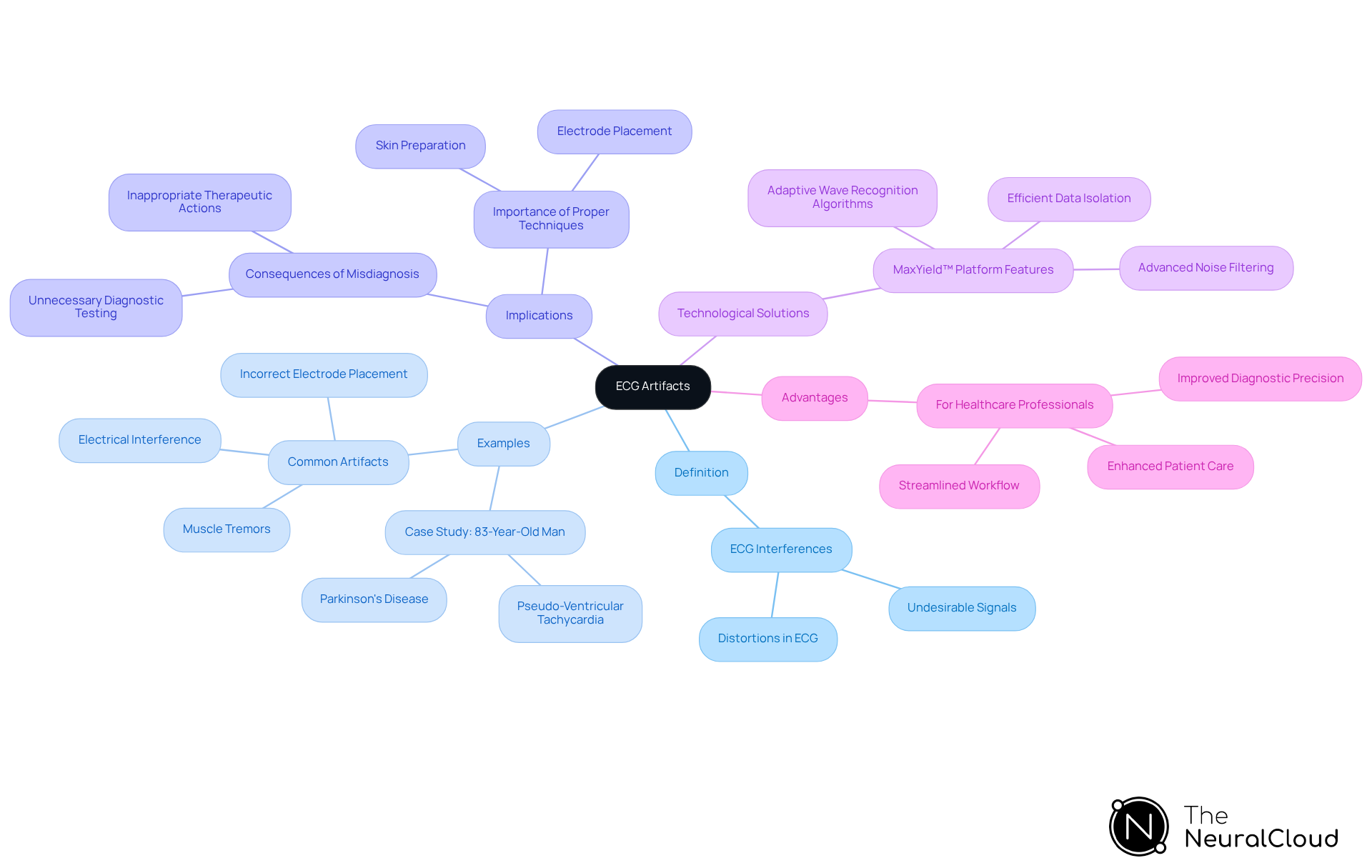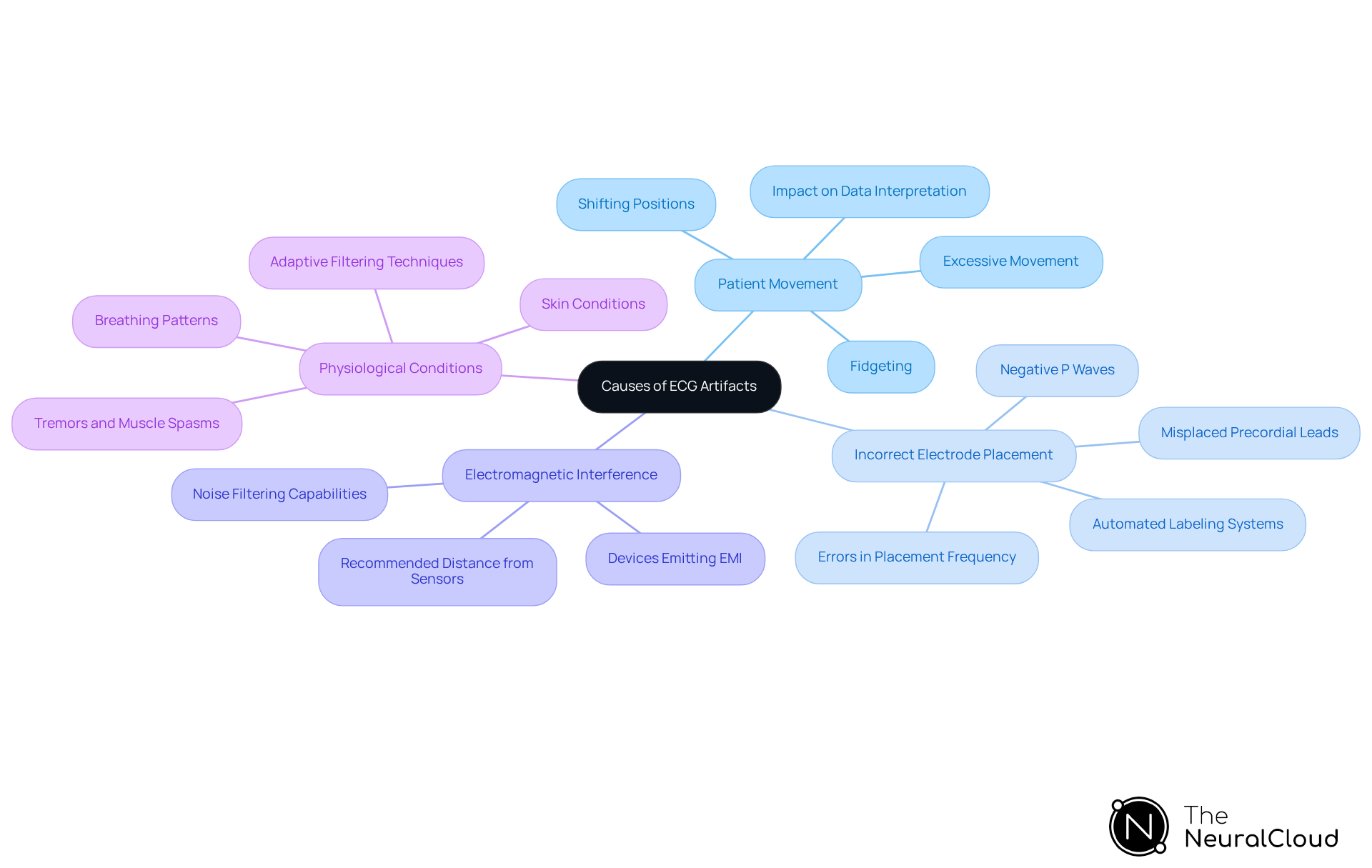Overview
ECG artifacts represent undesirable signals in electrocardiograms, arising from factors such as patient movement, electrical interference, and incorrect electrode placement. These artifacts can obscure the heart's true electrical activity, leading to potential misdiagnosis. Therefore, accurately identifying these artifacts is crucial. The MaxYield™ platform addresses these challenges by enhancing signal clarity and diagnostic precision.
The MaxYield™ platform features advanced algorithms designed to filter out noise and improve the quality of ECG signals. This capability allows healthcare professionals to obtain clearer readings, ultimately leading to more accurate diagnoses. By leveraging this technology, clinicians can trust that the data they are analyzing reflects the patient's true cardiac condition.
The advantages of using the MaxYield™ platform extend beyond improved signal quality. It enhances patient outcomes by enabling timely and accurate interventions based on reliable ECG analysis. As a result, healthcare professionals can make informed decisions that significantly impact patient care.
In summary, the MaxYield™ platform not only addresses the common challenges associated with ECG artifacts but also provides healthcare professionals with a powerful tool to enhance their diagnostic capabilities. By improving the clarity of ECG signals, it ultimately contributes to better patient outcomes.
Introduction
Understanding the nuances of electrocardiograms (ECGs) is essential for healthcare professionals, as misinterpretations can lead to significant clinical consequences. ECG artifacts—unwanted signals that obscure the heart's electrical activity—pose a critical challenge in accurately diagnosing cardiac conditions. This article delves into the various types of ECG artifacts, their causes, and the profound impact they can have on patient care. Clinicians must effectively distinguish between genuine heart rhythms and misleading distortions, and explore innovative strategies to enhance diagnostic accuracy.
Define ECG Artifacts and Their Importance
What is an ECG artifact refers to ECG interferences that represent undesirable signals or distortions in an electrocardiogram, obscuring the heart's true electrical activity. These interferences, which raise the question of what is an ECG artifact, can stem from various origins, including individual movement, electrical interference, and incorrect electrode placement. For example, muscle tremors, often observed in patients with conditions like Parkinson's disease, can produce misleading waveforms that mimic serious arrhythmias, complicating diagnosis and treatment. An 83-year-old man with Parkinson's disease exhibited an ECG indicating signs of pseudo-ventricular tachycardia, underscoring the necessity for clinicians to differentiate between genuine dysrhythmias and misleading signals.
Accurate ECG readings are vital, as misinterpretations can lead to unnecessary diagnostic testing and interventions. A systematic review revealed a 14.3% misdiagnosis rate among residents due to ECG irregularities, highlighting ongoing deficiencies in interpretation skills across all training levels. Furthermore, research indicates that appropriate electrode positioning and skin preparation can reduce errors by as much as 70%, emphasizing the essential role of healthcare professionals in ensuring reliable ECG recordings.
Specialist opinions stress that recognizing what is an ECG artifact is crucial for effective patient care. Misdiagnosed issues may lead to inappropriate therapeutic actions, resulting in higher healthcare costs and patient discomfort. The 'Neural Cloud Solutions' platform addresses these challenges by utilizing advanced noise filtering and wave recognition algorithms that improve with each use. This technology enhances the efficiency of ECG analysis by swiftly isolating essential data from recordings affected by noise and distortions, while also recovering previously hidden segments of extensive recordings.
Educating healthcare professionals to identify and manage ECG disturbances, alongside employing innovative solutions such as MaxYield™, is essential for improving diagnostic accuracy and optimizing patient outcomes. Key features of the MaxYield™ platform include:
- Advanced noise filtering to enhance signal clarity.
- Adaptive wave recognition algorithms that evolve with usage.
- Efficient data isolation from distorted recordings.
The advantages for healthcare professionals are significant:
- Improved diagnostic precision and reduced misdiagnosis rates.
- Enhanced patient care through accurate ECG interpretation.
- Streamlined workflow, saving time and resources.
In conclusion, leveraging the MaxYield™ platform is crucial for healthcare professionals aiming to enhance their ECG analysis capabilities and ultimately improve patient outcomes.

Explore Common Types of ECG Artifacts
Common types of ECG artifacts include:
-
Motion Artifacts: These are caused by patient movement and can create irregularities in the ECG waveform. Research indicates that involuntary motions, such as shivering or changing positions, can introduce considerable noise, complicating the distinction between actual arrhythmias and distortions. For instance, muscle tremor distortions can mimic atrial flutter, which complicates precise diagnosis. Notably, 38% of nearly 500 electrophysiologists misidentified ventricular tachycardia as a false signal, underscoring the clinical implications of misidentifying motion disturbances. The MaxYield™ platform excels in isolating ECG waves from recordings affected by motion disturbances, ensuring critical data is accurately identified and labeled.
-
Electrical Interference: External electrical sources, including nearby medical equipment or power lines, can introduce high-frequency noise into the ECG signal. To mitigate this interference, it is essential to ensure that ECG machines are plugged into dedicated, grounded outlets and that other electronic devices are kept at a safe distance. MaxYield™ enhances signal clarity by filtering out such noise, resulting in more reliable readings.
-
Baseline Wander: Often caused by respiratory movements or poor electrode contact, this phenomenon results in fluctuations in the baseline of the ECG trace. Proper skin preparation and the use of fresh gel-based electrodes can significantly reduce baseline wander, thereby improving signal quality. In fact, correct electrode placement and skin preparation can decrease ECG disturbances by up to 70%, highlighting the importance of these practices. The system can salvage previously obscured sections of lengthy Holter and patch monitor recordings, transforming them into clean, crisp signals.
-
Muscle Artifacts: Involuntary muscle contractions can produce spikes or irregularities in the ECG waveform. Encouraging patients to relax and hold their breath briefly during recordings can help minimize these distortions. The advanced noise filtering features of MaxYield™ facilitate the efficient identification and control of muscle interferences, enhancing the overall precision of ECG interpretations.
Clinicians must understand what is an ECG artifact to accurately interpret ECG data. Understanding what is an ECG artifact is crucial, as misunderstandings caused by distortions can lead to unnecessary treatments and increased healthcare costs, emphasizing the importance of correct electrode positioning and patient management during ECG recordings. As noted by Davidenko and Snyder, baseline abnormalities frequently result in the misdiagnosis of atrial fibrillation by healthcare personnel, stressing the need for vigilance in ECG analysis. With MaxYield™, the integration of automated labeling and advanced AI technology transforms the ECG analysis process, addressing inefficiencies and improving diagnostic outcomes. The algorithm evolves with each use, continuously enhancing its diagnostic yield, which is vital for accurate ECG interpretation.

Identify Causes of ECG Artifacts
Understanding what is an ECG artifact is essential, as ECG disturbances can arise from various factors, significantly impacting the accuracy of readings. Key contributors include:
-
Patient Movement: Shifting positions or fidgeting can disrupt electrode placement, leading to motion artifacts. Excessive movement during an ECG test can lead to what is an ECG artifact, which introduces noise or distortions in the results and complicates data interpretation. Research indicates that motion disturbances can exhibit amplitudes similar to or greater than the ECG signal itself, which raises the question of what is an ECG artifact, making it crucial to minimize patient movement during recordings. The 'Neural Cloud Solutions' platform aids in isolating ECG waves from recordings affected by motion disturbances, enhancing data clarity and recovering previously obscured sections.
-
Incorrectly positioned electrodes can yield inaccurate readings and increase susceptibility to what is an ECG artifact. For example, misplacing precordial leads can produce negative P waves and triphasic patterns that may mimic serious cardiac conditions. Research shows that errors in electrode placement occur in 0.4% to 4% of ECGs performed, highlighting the necessity of proper technique. The system automates the labeling process, thereby reducing the risk of human error associated with electrode placement.
-
Devices such as cell phones, computers, and other medical equipment can emit electromagnetic interference, which raises the question of what is an ECG artifact that distorts the ECG signal. It is recommended to keep cell phones at least 25 cm away from the ECG sensor module to prevent such interference. The advanced noise filtering capabilities of this system effectively identify and mitigate the impact of electrical noise, which raises the question of what is an ECG artifact, on ECG recordings.
-
Conditions such as tremors, muscle spasms, or even breathing patterns can introduce variability in the ECG waveform, which leads us to consider what is an ECG artifact. For instance, muscle tremors can occur when cold individuals shiver or when individuals support themselves with their arms, complicating analysis. Additionally, skin conditions like excessive sweating or oily skin can diminish the quality of electrode contact during an ECG. The flexibility of this product allows it to evolve with each application, continually enhancing its precision in identifying and addressing these physiological irregularities.
By recognizing these causes and leveraging the capabilities of MaxYield™, healthcare professionals can proactively mitigate their impact, ensuring more reliable ECG readings and improved patient outcomes. Identifying these factors is essential, as they may lead to unnecessary tests and additional expenses in treatment measures.

Implement Strategies for Reducing ECG Artifacts
To effectively reduce ECG artifacts, healthcare professionals can adopt several key strategies:
-
Ensure Proper Electrode Placement: Adhering to standardized protocols for electrode placement is crucial. Studies indicate that only 10% of healthcare workers correctly position all ECG leads, with common errors including V1 and V2 being placed too high and V5 and V6 too close to the center. Correct placement is essential for accurate readings and can significantly enhance the reliability of results, especially when considering what is an ECG artifact.
-
Restrict Individual Movement: Directing individuals to stay still during the ECG recording is crucial for reducing motion disturbances. Techniques such as ensuring patient comfort and providing warmth can help reduce muscle tremors, which are often exacerbated by cold environments.
-
Use Shielded Cables: Employing shielded ECG cables can mitigate electrical interference from external sources, such as power lines and other equipment. This is particularly important in busy clinical settings where multiple devices may be in use.
-
Optimize Equipment Settings: Adjusting the gain and filtering settings on ECG machines can improve signal clarity and reduce noise, which is essential for understanding what is an ECG artifact. For example, lowering the low-pass filter (LPF) to 40 Hz has been demonstrated to enhance ECG clarity by reducing disturbances while maintaining high-frequency elements essential for precise diagnosis.
-
Utilize Advanced Analysis Tools: Platforms such as those from Neural Cloud Solutions can automate the identification and correction of artifacts, allowing clinicians to concentrate on interpreting high-quality ECG data. MaxYield™ rapidly labels P, QRS, and T Wave onsets and offsets, providing beat-by-beat tabulation in CSV format for easy integration into existing workflows. Additionally, it supports the discovery of new digital biomarkers, showcasing the effectiveness of advanced technology in addressing ECG challenges.
By implementing these strategies, healthcare providers can significantly improve the accuracy and reliability of ECG readings, ultimately leading to better patient outcomes.

Conclusion
Understanding ECG artifacts is essential for ensuring accurate cardiac monitoring and diagnosis. These interferences can stem from numerous factors, including patient movement, electrical interference, and improper electrode placement, obscuring the heart's true electrical activity. Misinterpreting these artifacts can have significant implications, potentially leading to unnecessary diagnostic procedures and treatments that may harm patient care and inflate healthcare costs.
The article highlights various types of ECG artifacts, such as:
- Motion artifacts
- Electrical interference
- Baseline wander
- Muscle artifacts
Each presents unique challenges in clinical settings. Strategies for minimizing these disturbances are crucial, including:
- Proper electrode placement
- Restricting patient movement
- Utilizing advanced technologies like the MaxYield™ platform
This technology enhances signal clarity through noise filtering and aids in the accurate identification of ECG data, ultimately improving diagnostic precision.
Incorporating these insights and strategies into clinical practice is vital for healthcare professionals. By recognizing and managing ECG artifacts effectively, clinicians can enhance their diagnostic capabilities, improve patient outcomes, and reduce the risk of misdiagnosis. Embracing advanced technological solutions and adhering to best practices ensures that the complexities of ECG readings are navigated successfully, leading to better healthcare delivery and patient safety.
Frequently Asked Questions
What is an ECG artifact?
An ECG artifact refers to undesirable signals or distortions in an electrocardiogram that obscure the heart's true electrical activity. These interferences can arise from various sources, including individual movement, electrical interference, and incorrect electrode placement.
Why is it important to understand ECG artifacts?
Understanding ECG artifacts is crucial because misinterpretations can lead to unnecessary diagnostic testing and interventions. Misdiagnosed issues may result in inappropriate therapeutic actions, higher healthcare costs, and patient discomfort.
What are some common causes of ECG artifacts?
Common causes of ECG artifacts include individual movement, electrical interference, incorrect electrode placement, and muscle tremors, especially in patients with conditions like Parkinson's disease.
How can ECG artifacts affect patient diagnosis?
ECG artifacts can produce misleading waveforms that mimic serious arrhythmias, complicating diagnosis and treatment. For example, muscle tremors in a patient may lead to an incorrect interpretation of the ECG.
What is the misdiagnosis rate associated with ECG irregularities?
A systematic review revealed a 14.3% misdiagnosis rate among residents due to ECG irregularities, indicating ongoing deficiencies in interpretation skills across all training levels.
How can proper electrode positioning and skin preparation impact ECG readings?
Appropriate electrode positioning and skin preparation can reduce errors in ECG readings by as much as 70%, highlighting the essential role of healthcare professionals in ensuring reliable recordings.
What is the 'Neural Cloud Solutions' platform?
The 'Neural Cloud Solutions' platform utilizes advanced noise filtering and wave recognition algorithms to improve ECG analysis by isolating essential data from recordings affected by noise and distortions.
What are the key features of the MaxYield™ platform?
Key features of the MaxYield™ platform include advanced noise filtering, adaptive wave recognition algorithms that evolve with usage, and efficient data isolation from distorted recordings.
What advantages does the MaxYield™ platform offer to healthcare professionals?
The MaxYield™ platform offers improved diagnostic precision, reduced misdiagnosis rates, enhanced patient care through accurate ECG interpretation, and a streamlined workflow that saves time and resources.
Why is educating healthcare professionals about ECG disturbances important?
Educating healthcare professionals to identify and manage ECG disturbances is essential for improving diagnostic accuracy and optimizing patient outcomes.






